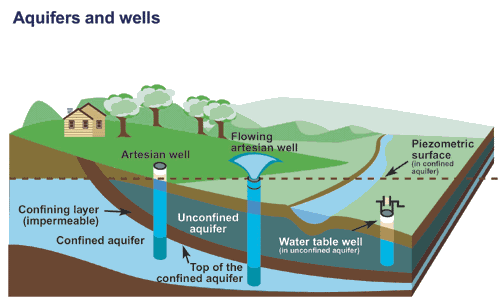4 Complete Geological Formations of Groundwater (The 4-Aqui’s)
Compiled by Stanley Udegbunam || Dec 06, 2020
In today’s article, we will be looking at the 4 different geological formations of groundwater which I call the 4 -Aqui’s.
What does the term “4-Aqui’s” means? You will find out shortly as we proceed.
There’s a comparison table towards the end of the article to give you a clearer understanding of the various geological formations of groundwater.
Without further ado, let’s get started.
AFRILCATE
GEOLOGICAL FORMATIONS OF GROUNDWATER
Groundwater is the largest source of freshwater for mankind and approximately 30% of the freshwater on Earth is groundwater.
It is the water present beneath earth’s surface in soil pore spaces, underground bedrocks and in the fractures of rock formations.
Groundwater forms when rainwater infiltrates the soil through precipitation and percolates downwards until it reaches the water table.
In hydrology, this process of groundwater formation is called recharge.
They are four different types of geological formations of groundwater:
- Aquifer
- Aquitard
- Aquiclude
- Aquifuge
This is what we refer to as the 4-Aqui’s✅
WHAT IS AN AQUIFER?
An aquifer is a body of porous rock or sediments saturated with groundwater.
They are highly permeable and porous geological formations.
Aquifers are made of unconsolidated materials like sand, gravel, and rocks that store and transmit water.
Generally, there are two types of aquifers:
- Unconfined Aquifer
- Confined Aquifer
The difference between an unconfined and confined aquifer is that:
An unconfined aquifer has a layer of permeable material above it which allows for water seepage into the aquifer.
While a confined aquifer has layers of impermeable rock or clay above it which hinders the passage of water into the aquifer.
The restricting layers of confined aquifer offer some protection from surface contamination, unlike the unconfined aquifer.

Geological Formations of Groundwater: confined and unconfined aquifer
STILL CURIOUS?
We have a stand-alone article that takes you through everything you need to know about aquifers.
see it here:
WHAT IS AN AQUITARD?
Aquitard is a saturated, poorly permeable geological unit that retard the flow of groundwater.
They partially disrupt the flow of groundwater by acting as separation layers between aquifers.
Although water cannot flow very fast through an aquitard, significant quantities of water can still seep through aquitards in some conditions.
This signifies that aquitards are porous and partially permeable.
A typical example of aquitard is sandy clay and a poorly fractured igneous or metamorphic rock.
One common misconception is that Aquitard stops underground water flow, this is wrong.
Aquitard only slows down the groundwater flow, it doesn’t stop it completely.
Therefore, an aquifer with layers of aquitard above it is unconfined.
WHAT IS AN AQUICLUDE?
Aquiclude is a saturated, geological formation, which is porous but not permeable.
By been porous, It means that aquicludes have pore spaces that can contain and store large amount of water.
Not permeable – signifies that aquicludes don’t allow for the percolation of water downstream to the aquifers.
Unlike aquitard, aquicludes completely block the passage of groundwater unless been acted upon by external pressure.
An aquifer with a layer of aquiclude above it is said to be confined.
Typical examples of aquicludes are argillaceous rocks like shale and clay.
WHAT IS AN AQUIFUGE?
Aquifuge is a geological formation that is neither porous nor permeable.
Aquifuges don’t store water and since there are no interconnected openings, water can’t also flow through.
Naturally, aquifuges are not suitable for groundwater occurrence.
Typical examples of aquifuges include:
- Compact rocks like massive granites
- basalt and
- quartzite
Aquifers with layers of aquifuge above it are said to be confined.
COMPARISON OF THE DIFFERENT GEOLOGICAL FORMATIONS OF GROUNDWATER
| Properties | AQUIFER | AQUITARD | AQUICLUDE | AQUIFUGE |
|---|---|---|---|---|
| POROSITY | ✅ | ✅ | ✅ | ❌ |
| PERMEABILITY | ✅ | Partially | ❌ | ❌ |
| YIELD OF WATER | ✅ | Slow Yielding | ❌ | ❌ |
| EXAMPLES | Underground gravel and sand layers | sandy clay and a poorly fractured igneous or metamorphic rock. | Argillaceous rocks like shale and clay. | Compact rocks like massive granites, basalt and quartzite |
Slide sideways to view the complete table.
| Properties | AQUIFER | AQUITARD | AQUICLUDE | AQUIFUGE |
|---|---|---|---|---|
| POROSITY | ✅ | ✅ | ✅ | ❌ |
| PERMEABILITY | ✅ | Partially | ❌ | ❌ |
| YIELD OF WATER | ✅ | Slow Yielding | ❌ | ❌ |
| EXAMPLES | Underground gravel and sand layers | sandy clay and a poorly fractured igneous or metamorphic rock. | Argillaceous rocks like shale and clay. | Compact rocks like massive granites, basalt and quartzite |
SUMMARY – Geological Formations Distinction (at a glance)
While porosity is a measure of empty space (pores) in a material, permeability measures the ease of water flow as a result of the interconnection of these pore spaces.
You can see more distinction between porosity and permeability here: porosity vs permeability
These two soil properties can be used to give a summarized distinction between the 4-aqui’s of groundwater geologic formations (aquifers, aquitard, aquiclude, and aquifuge).
- Aquifers – geologic formations having both porosity and permeability.
- Aquitard- geologic formations having porosity but low permeability.
- Aquicludes – geologic formations having porosity but no permeability.
- Aquifuge – geologic formations having neither porosity nor permeability.
DO YOU KNOW?
This means it can take several thousands of years for underground aquifers to become replenished.
DO YOU KNOW?
Unlike surface water, groundwater can move as slow as a meter per year.
This means it can take several thousands of years for underground aquifers to become replenished.


what an interesting clarification with a short and precise forms. before this day, I always miss understood their meanings.
I must say, I have been enlightened. Reading this article has clarified all my misunderstandings. Good job done.